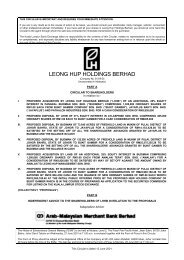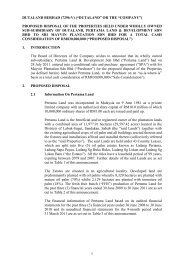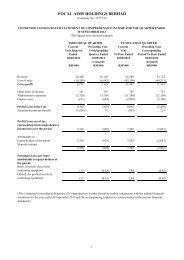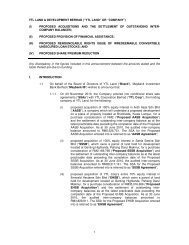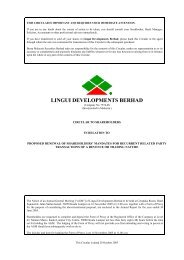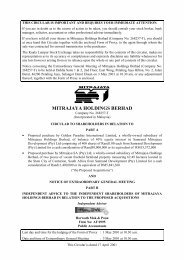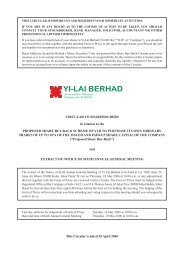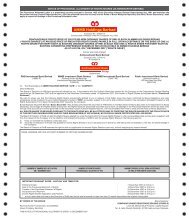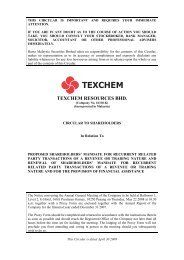GPERAK-AnnualReport2009 (1MB).pdf - Bursa Malaysia
GPERAK-AnnualReport2009 (1MB).pdf - Bursa Malaysia
GPERAK-AnnualReport2009 (1MB).pdf - Bursa Malaysia
You also want an ePaper? Increase the reach of your titles
YUMPU automatically turns print PDFs into web optimized ePapers that Google loves.
annual report 2009 | Gula peraK BerHaD (8104-X)<br />
NOTES TO THE FINANCIAL STATEMENTS (Cont’d)<br />
3. SIGNIFICANT ACCOUNTING POLICIES (Cont’d)<br />
Revenue<br />
Revenue from hotel operations and oil palm plantation are recognised upon delivery of products or performance of service,<br />
net of sales tax and discounts.<br />
Profit from property development and construction contracts are recognised using the percentage of completion method.<br />
The stage of completion is measured by reference to the actual cost incurred to date to estimated total cost of each<br />
contract. All foreseeable losses are recognised as soon as they are anticipated.<br />
Rental income from shoplots is recognised on an accrual basis unless collectability is in doubt. Interest income is recognised<br />
as it accrues.<br />
Income Tax<br />
Income tax for the year comprises current and deferred tax. Current tax is the expected amount of income taxes payable<br />
in respect of the taxable profit for the year and is measured using the tax rates that have been enacted or substantively<br />
enacted at the balance sheet date.<br />
Deferred tax is accounted for using the “balance sheet liability” method in respect of temporary differences arising from<br />
differences between the carrying amounts of assets and liabilities in the financial statements and their corresponding tax<br />
bases used in the computation of taxable profit.<br />
In principle, deferred tax liabilities are recognised for all taxable temporary differences, and deferred tax assets are<br />
recognised for all deductible temporary differences, unutilised tax losses and unabsorbed capital allowances to the extent<br />
that it is probable that future taxable profit will be available against which the deductible temporary differences, unutilised<br />
tax losses and unabsorbed capital allowances can be utilised.<br />
Deferred tax is measured at tax rates that are expected to apply in the period when the asset is realised or the liability<br />
is settled, based on tax rates that have been enacted or substantively enacted at the balance sheet date. Deferred tax is<br />
recognised in the income statements, except when it arises from a transaction which is recognised directly in equity, in which<br />
case the deferred tax is also charged or credited directly in equity. Deferred tax is provided for temporary differences arising<br />
from surplus on revaluation of a hotel property and investment properties of the Group.<br />
Functional Currency and Foreign Currencies Conversion<br />
The individual financial statements of each entity in the Group are presented in the currency of the primary economic<br />
environment in which the entity operates (its functional currency). The functional currency of each entity in the Group is<br />
Ringgit <strong>Malaysia</strong>. For the purpose of the consolidated financial statements, the results and financial position of each entity<br />
are expressed in Ringgit <strong>Malaysia</strong>, which is the functional currency of the Group and the Company, and the presentation<br />
currency for the consolidated financial statements.<br />
In preparing the financial statements of the Company, transactions in currencies other than the Company’s functional<br />
currency (foreign currencies) are recorded at the rates of exchange prevailing on the dates of the transactions. At each<br />
balance sheet date, monetary items denominated in foreign currencies are retranslated at the rates prevailing on the<br />
balance sheet date. Non-monetary items carried at fair value that are denominated in foreign currencies are retranslated<br />
at the rates prevailing on the date when the fair value was determined. Non-monetary items that are measured in terms of<br />
historical cost in a foreign currency are not retranslated.<br />
Exchange differences arising on the settlement of monetary items, and on the retranslation of monetary items, are included<br />
in profit or loss for the period. Exchange differences arising on the retranslation of non-monetary items carried at fair value<br />
are included in profit or loss for the period except for differences (if any) arising on the retranslation of non-monetary<br />
items in respect of which gains and losses are recognised directly in equity. For such non-monetary items, any exchange<br />
component of that gain or loss is also recognised directly in equity.<br />
45<br />
www.gulaperak.com.my




